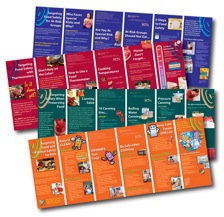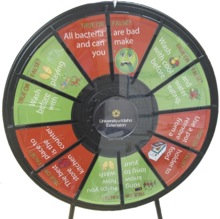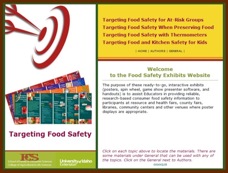 |
October 2010
|
October 2010 // Volume 48 // Number 5 // Tools of the Trade // v48-5tt10
Ready-to-Go Exhibits Expand Consumer Food Safety Knowledge and Action
Abstract
Ready-to-go, interactive food safety exhibits were developed to allow Extension Educators the opportunity to communicate the magnitude of food safety risk and to prevent foodborne illness. Four food safety topics were chosen: 1) At‐Risk Groups, 2) Preserving Food, 3) Food Thermometers, 4) Kitchen Safety for Kids. Data collected showed an increase in food safety knowledge and planned behavior change.
Background
Idaho Family & Consumer Sciences (FCS) Extension educators are often given the opportunity to present at local resource and health fairs, county fairs, libraries, community centers, schools, and other locations. These opportunities allow educators to maintain a strong presence in their community, market the university, and provide reliable, research-based information to participants. Requests to provide an exhibit are sometimes last minute, so a ready-to-go exhibit allows outreach to occur even when time is limited. Displays are an effective method for reinforcing and disseminating information to consumers (Ensle, 2009). These fairs are a perfect venue to educate participants in food safety.
One-on-one contact with a local expert who can answer a participant's food safety question is oftentimes invaluable and can lead to linking participants to University of Idaho Extension in the future, when other food safety questions arise. Consumers who understand the magnitude of food safety risk and the serious nature of some of the foodborne illnesses are more likely to take steps to prevent foodborne illness for themselves and their family members (Redmond & Griffith, 2004).
In November 2005, a team of food safety educators identified the need for an attractive, ready-to-go food safety exhibit because food safety education was oftentimes the topic requested by fair organizers. A professional, well-designed exhibit that would include a number of interchangeable information "panels" and resource notebook would provide Extension personnel with the greatest flexibility in presenting food safety topics at a variety of consumer venues.
Program Development
A six-member development team consisting of the Extension Food Safety specialist and five FCS Extension educators representing each of Idaho's Extension Districts with expertise in food safety planned the content and format of the food safety exhibits. Four food safety topics were selected by surveying FCS Educators across Idaho to identify and rank topics in order of consumer interest and importance: 1) At‐Risk Groups, 2) Preserving Food, 3) Food Thermometers, 4) Kitchen Safety for Kids. The unifying theme was Targeting Food Safety.
Research was conducted to identify and select the most important food safety information for each of the four topics and to identify appropriate visual aids or handout materials. The team reviewed and edited the information for each topic and worked with a desktop publishing specialist to create the design. After completing the content and design, each poster was sent to a food safety extension expert on that topic for review:
- Dr. Lydia Medeiros, Department of Human Nutrition, The Ohio State University, Targeting Food Safety for At-Risk Groups
- Dr. Elizabeth Andress, Department of Food and Nutrition, University of Georgia, Targeting Food Safety When Preserving Food
- Ms. Zena Edwards, Nutrition Education and Food Safety Faculty, Thurston County Extension, Washington State University, Targeting Food Safety with Thermometers
- Dr. Judy Harrison, Department of Food and Nutrition, University of Georgia, Targeting Food and Kitchen Safety for Kids
Suggestions made by these reviewers were incorporated.
Coordinating bookmarks were developed as handouts for each topic. In addition, appropriate handouts for each topic were identified or developed.
Delivery
The posters (Figure 1) were delivered using a display system that fit a majority of the expected display spaces. The poster panels were colorful, well illustrated, and attractive. They also had a uniform design and format, so they could be used interchangeably and tailored to specific audiences.
Figure 1.
Targeting Food Safety Posters

In addition, interactive components were developed to provide a "hook" to generate consumer interest. A 31‐inch diameter spin wheel (Figure 2) with question "wedges" for each topic allowed participants to spin the wheel and answer a food safety question, while the Game Show Presenter software with questions programmed for each topic displayed a virtual game show emcee character and audio track to encourage participation. Additionally, dial and digital thermometers with the thermometer stems painted red to indicate depth of insertion and a food model of a hamburger patty were used for the Targeting Food Safety with Thermometers exhibit; 16 coloring pages and two food safety stickers were added to the Kitchen Safety for Kids exhibit.
Figure 2.
Targeting Food Safety
Spin Wheel

A Web site (Figure 3) was also developed to assist Educators in using these exhibits <http://www.agls.uidaho.edu/foodsafety/>. The Web site provides convenient access to downloadable, print-ready copies of all the handouts and bookmarks, as well as a downloadable version of each poster.
Figure 3.
Targeting Food Safety Web Site

Evaluation
One of the exhibits, Targeting Food Safety with Thermometers, was selected for evaluation because of its relevance to a variety of different venues. In order to capture pre/post-data from poster attendees, a retrospective pretest evaluation was developed (Kiernan, 2001). A retrospective pretest was chosen because of its convenience and expeditious method of assessing changes in self-reported knowledge and skills. (Pratt, McGuigan, & Katzev, 2000). Evaluation questions asked about knowledge and behavior regarding the use of food thermometers to test doneness when cooking ground beef patties. The evaluation form was pilot-tested at a statewide Extension conference poster session in 2007. Three venues were then chosen for data collection, a community hospital health fair, a county health fair for employees, and a county fair. Seventy-five consumers completed the evaluation.
Post data showed an increase in the awareness of instant-read thermometers and an increase in knowledge about the importance of using an instant-read thermometer, and many people indicated that they would start using an instant-read thermometer for testing hamburger patties (Table 1).
| BEFORE seeing this exhibit... | Agree | AFTER seeing this exhibit... | Agree |
| Q1. I knew it is important to use an instant-read thermometer when testing hamburger patties to see if they are safely cooked. | 63% | Q4. I know it is important to use an instant-read thermometer when testing hamburger patties to see if they are safely cooked. | 92% |
| Q2. I knew about instant-read thermometers. | 55% | Q5. I know about instant-read thermometers. | 93% |
| Q3. I tested the internal temperature of hamburger patties with a food thermometer. | 29% | Q6. I will test the internal temperature of hamburger patties with a food thermometer. | 83% |
Conclusion
The Targeting Food Safety exhibits and resources were presented to Idaho FCS Extension Educators during their 2007 FCS In-Service, and again at the 2008 JCEP Galaxy III Conference in Indianapolis, Indiana. These ready-to-go exhibits have assisted Idaho FCS Educators in providing reliable, research-based consumer food safety information to participants at a variety of venues throughout the state. The Logic Model was used to design and evaluate the impact of the project. Team members assessed the situation, developed quality resources to share food safety information with the public, marketed and disseminated the resources, and assessed the impact of one of the exhibits on the general public. Individuals surveyed showed an increase in knowledge and in planned behavior changes. The exhibits have been well used in Idaho, displayed 37 times in a 12-month period.
References
Ensle, K. M. (2008). Creating quick and easy displays for Extension events. Journal of Extension (On-line), 46(2) Article 2TOT2. Available at: http://www.joe.org/joe/2008april/tt2.php
Redmond, E.C., & Griffith, C.J. (2004). Consumer attitudes and perceptions towards microbial food safety in the domestic kitchen. Journal of Food Safety, 24:169-194.
Kiernan, N. E. (2001). Reduce bias with retrospective questions: Tipsheet #30, University Park, PA: Penn State Cooperative Extension.
Pratt, C. C., McGuigan, W., & Katzev, A. R. (2000). Measuring program outcomes: Using Retrospective Pretest Methodology. American Journal of Evaluation, 21:341-349.



